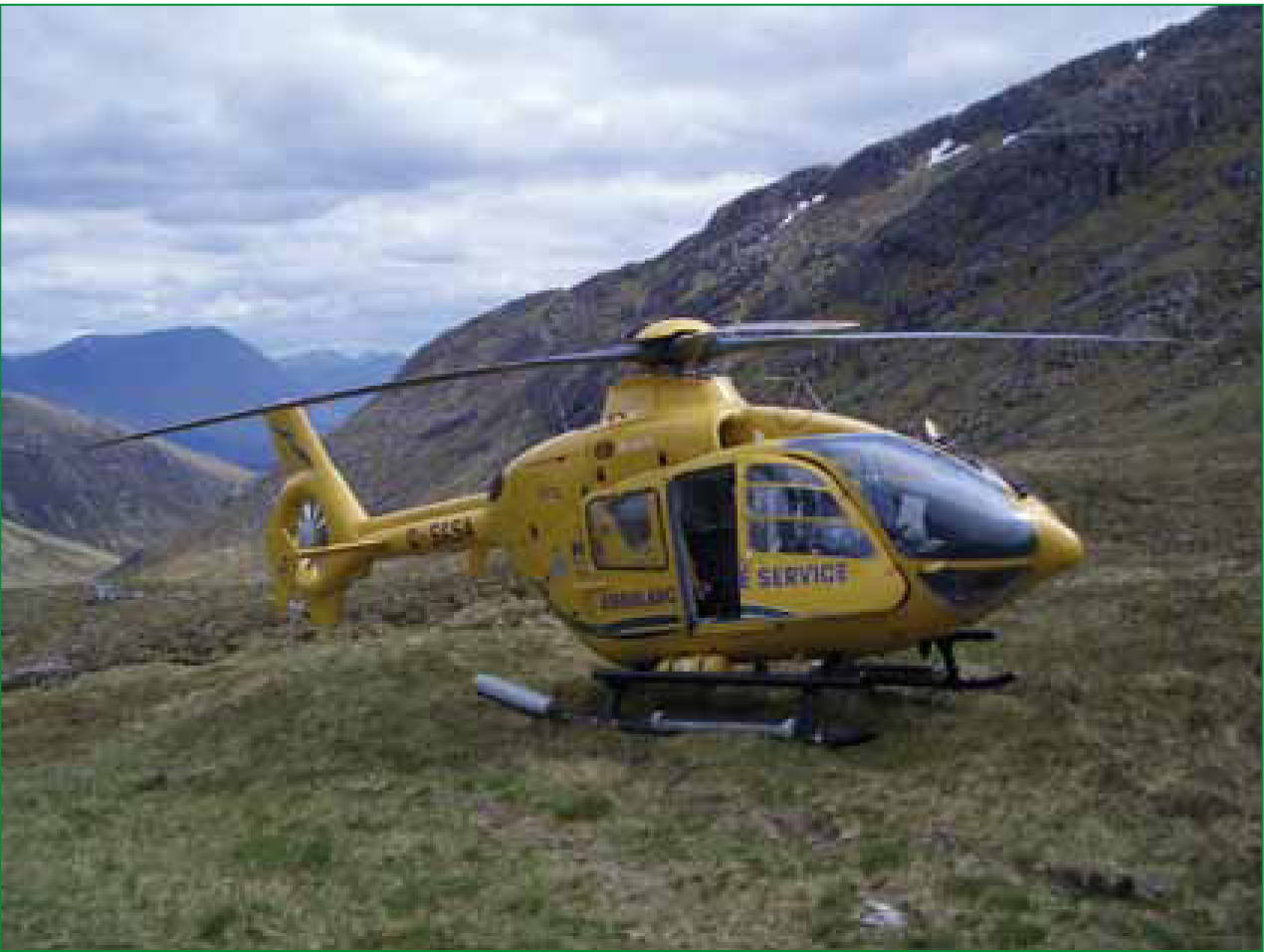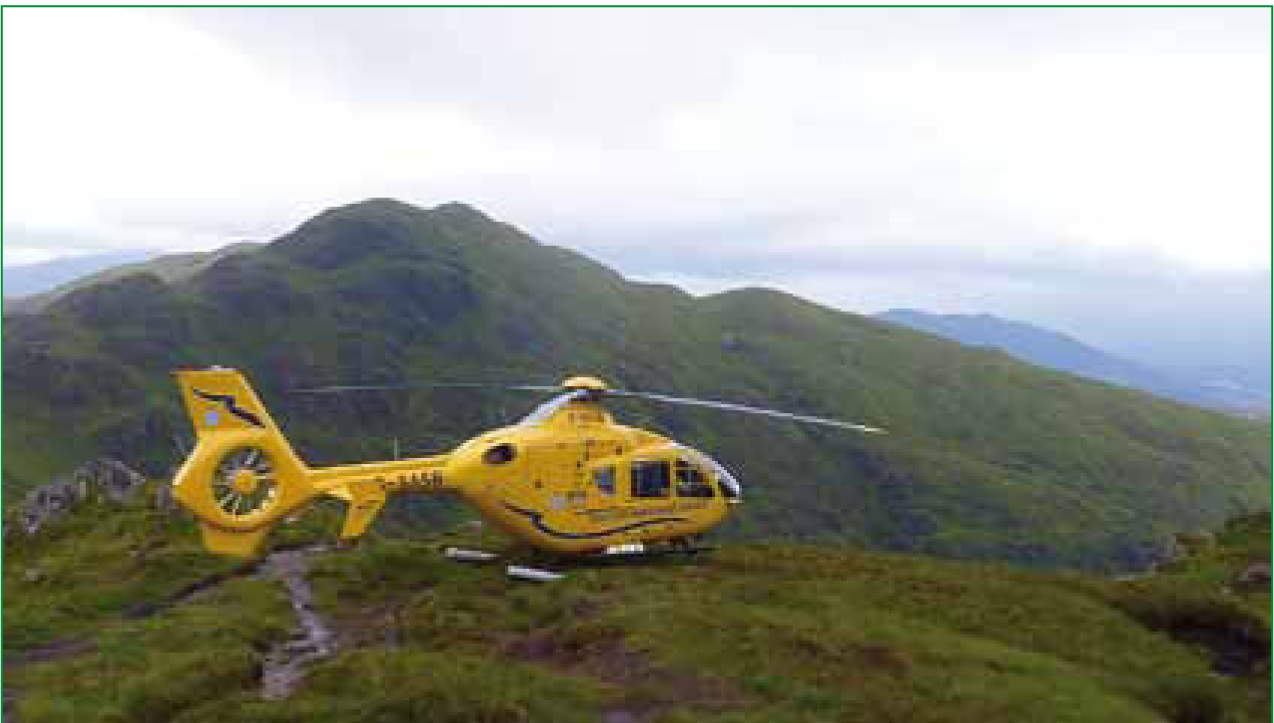There are many models of air ambulance service delivery worldwide. Due to the vast differences in service delivery, operational scope, staffing, clinical competencies and geography, direct comparison can be difficult. Within the literature around air ambulance use, the number of prospective randomized studies is small but increasing with a large amount of observational data available. Notwithstanding these caveats, there is significant information available in the scientific literature and recurrent themes are evident.
Air ambulance services are delivered using both fixed wing and rotary aircraft. Helicopter (rotary wing) air ambulances are often high profile prehospital emergency medical resources carrying out primary response, often incorporating search and rescue capability as well as secondary transport and retrieval (Figure 1). Within some services, helicopter air ambulances are also used for non–emergency transport and repatriation also.

Fixed wing air ambulance resources usually carry out secondary retrieval, interhospital transfer and repatriation, often across larger distances. Fixed wing ambulances are also used to deliver primary care and public health in large landmasses such as Australia. Primary responses are more challenging for fixed wing aircraft due to the need for a suitable landing strip, but this is not unheard of in Australia.
Rationale
Given the expense and potential hazard of air ambulance operations, there has to be a sound rationale for their use. Generally, air ambulances can confer four broad categories of benefit.
Rapid access to paramedical skills
Particularly in remote and rural areas, there can be significant delay for patients to access primary response by land paramedics due to relatively low population density and the geographical disparity of emergency medical services provision (Cameron and Zalstein, 1998). An air ambulance can cover a vastly greater area than a single land ambulance.
Where population densities are low, economically, it can be difficult to justify having enough land ambulances to achieve desirable response times. An air ambulance crewed by a paramedic trained to the same level as an equivalent local land ambulance paramedic can allow equity of access to paramedical skills.
Transport of patients to hospital
Patients can be conveyed to hospital via ground, rotary or fixed-wing aircraft or a combination of any or all three modes of transport. An air ambulance can be useful in two separate scenarios—first for patients with a time critical need for a particular intervention.
Particularly where patients require a time critical transport to hospital, for instance, a patient with a myocardial infarction being transported for primary percutaneous coronary intervention (PPCI) (Silbergleit and Blumstein, 1995) or stroke thrombolysis (Silbergleit et al. 2003), the method of transport used will affect the speed with which a patient can be conveyed.
Second, if there are prolonged land transport times to hospital, the use of an air ambulance can allow land crews to remain locally to respond to incidents while an air ambulance is used for primary or secondary transport to hospital some distance away (Svenson, 2006).
From a purely transport aspect, ground assets are generally a more appropriate method of transport where the transport time by road is less than 45 minutes (Nicholl, 1997; Biewener et al, 2004; Black et al 2004). This is due to the fact that although air assets have a greater speed when moving, air ambulances generally require longer to load and secure a patient for transport. This effect is increased where an air ambulance is unable to land either at the patient's initial location or destination.
For transport of patients greater than 45 minutes duration by land, rotary aircraft are more beneficial within a 225 km radius from base or hospital, with fixed wing being more useful for distances greater than 225 km (Figure 1) (Powell et al, 1997; Whitely et al, 2002; Goldstien et al, 2003).
Rapid access of patients to critical care skills
The addition of appropriately trained staff and equipment to an air ambulance can allow the delivery of critical care skills to patients requiring a level of intervention beyond that available by a standard land paramedic response. This staffing can be a critical care paramedic or nurse, flight paramedic, an appropriately trained physician or any combination of these healthcare professionals.
These staff can deliver critical care interventions such as emergency anaesthesia, ventilation, chest injury management with thoracostomies, sedation, minor surgical procedures, cardioversion, and invasive monitoring to patients who are either seriously injured or have critical illness. This team can also facilitate triage of patients to definitive care where appropriate (Carron et al, 2010).
Evidence suggests that an appropriately skilled and governed physician and/or critical care paramedic team deployed by air can improve patient outcomes (Baxt and Moody, 1997; Barttolacci et al, 1998; Garner et al, 1999; Frankema et al, 2004) although controversy and confounding factors still cause debate (Hamman et al, 1991; Burney et al, 1995). The outcome of the head injury retrieval trial (HIRT) currently underway in Australia (Garner, 2009) will add significantly to this debate, with results currently expected in 2011.
Local EMS capacity exceeded
Particularly for rotary wing aircraft, air ambulances offer a platform that is rapidly deployable to almost any location over a large geographical area (Figure 2). They, therefore, deliver the capability to provide extra resources to a scene where the supply of ambulance resource is outstripped by demand (American College of Emergency Physicians, 2008). Classically this is a multi-casualty or, on rare occasions, major incident scenario, where the deployment of air resources may be beneficial.

Particularly in remote and rural areas, the scale of incident required to outstrip locally available ambulance provision may not be as large as in an urban area. The role that air resources perform at a major incident is less clear. In addition to the categories outlined above where air resources can provide benefit, there are additional considerations during major incidents around transport of key personnel (such as medical or ambulance incident officers) as well as potential re-supply of medical equipment to scene.
‘An air ambulance crewed by a paramedic trained to the same level as an equivalent local land ambulance paramedic can allow equity of access to paramedical skills’
These additional roles were well described during the London bombings in July 2005 (London Air Ambulance, 2010).
Inevitably, some situations can have any combination or all four of the above reasons for deploying an air asset. The challenge is to develop a tasking system that allows early identification of appropriate patients for air ambulance use.
Implementation/solution
A potential model of care is ‘sieve and sort’ approach where a range of automatic triggers are set up within an ambulance service electronic computer aided dispatch system. When one of these triggers is activated, a paramedic or clinical advisor then gathers further information about the case before making an ultimate decision as to whether an air ambulance is justified. This system can work for primary work where decisions are required in a very short timescale (Nicholl et al. 1995; London Air Ambulance, 2010) or for secondary work over long distances (Shirley and Klein, 1999).
Intuitively, the additional cost required to employ a paramedic advisor is offset by more efficient tasking of expensive air ambulance assets, although published evidence to support this is lacking.
A number of tools have been proposed to assist in the clinical decision–making process to identify the minority of severely ill or injured patients that would benefit from priority access in the minimum amount of time to these expensive, limited and riskier air ambulance resources (Berns et al. 2001; Veldman et al, 2001; Goldstein et al, 2003; Black et al. 2004; Purtill et al, 2008).
The majority of triage tools proposed concentrate on trauma and the benefits of rapid transport to Level 1 Trauma Centres. The parameters of these tools often require prior clinical evaluation to establish some of the physiological parameters and are therefore designed for the rural hospital setting to quickly identify those patients that would benefit from rapid transfer to a higher level care centre.
The use of a number of these tools would need to be implemented with caution and prospectively evaluated. This is due to them being retrospectively reviewed and in theory, there is little prospective evidence following their proposal to support their use.
Wigman et al (2010) highlights the generally accepted current high specificity and moderate sensitivity of mechanism of injury and physiological parameter based dispatch criteria. A ‘sieve and sort’ approach improves the sensitivity of these triggers by adding clinical coordination with appropriately trained staff (Rashford and Myers, 2004).
With the need to deliver optimal reperfusion therapy and the shift towards primary percutaneous coronary intervention and thrombolysis for stroke, the use of air ambulance resources to gain rapid access to the appropriate facilities has been investigated (Berns et al. 2001; Thomas et al, 2002; Silbergleit et al. 2003; Thomas et al, 2006; Patel et al. 2007). The use of air ambulance resources may provide the means of delivering optimal reperfusion therapy depending on the staffing of the aircraft and time frames involved.
Due to the historically trauma focused HEMS triggers, the inclusion of time critical medical emergencies will also need to be embedded in to any dispatch trigger criterion. Locally the time to deploy and transfer patients on to air assets versus ground assets will need to be considered for all time critical patients. The need to transfer patients from air to land assets and vice versa to travel to the emergency department can add up to 15 minutes or more to the patient journey to definitive care (Black et al. 2004).
‘The challenge is to develop a tasking system that allows early identification of appropriate patients for air ambulance use’
One ambulance service in Australia has 31 triggers for rotary wing air ambulance embedded in their computer aided dispatch (CAD) programme. Some recent changes using air ambulance trained paramedics to ask further questions prior to committing the air ambulance has seen a 60% decrease in the aircraft being stood down enroute to the incident (Hogan, professional correspondence, 2010)
This enables the resource to be available for appropriate tasking and decreases the volume of ‘dead’ sectors or flights that do not carry or impact on patients are flown. In addition to this change, a dispatch algorithm is also in use that assists in the decision–making of the appropriate allocation of rotary wing, fixed wing or land resources and staffing levels required (Ambulance Victoria, 2010)
Ambulance services also need to have clearly defined roles for air assets during major incidents to avoid the scenario where one, or more, staffed air assets are immediately deployed to an incident scene without transporting key personnel or equipment to a scene. These protocols need to be developed and tested prior to an actual major incident.
Conclusion
This review continues to highlight a lack of standardized dispatch criteria and the need for both specific and sensitive tasking processes. Sensitivity can be improved by clinical coordination by appropriately trained and experienced dispatch staff.
Criterion will need to be tailored to the clinical capabilities and limitations of the available air ambulance and flight crew and consider alternative modes of response if required. An appropriately trained critical care team brings more knowledge, skills and equipment than a standard paramedic only crew to the benefit of patient care.
More focused research is required to develop best practice including appropriate generic and staff specific triggers. The ultimate aim is to deliver the right professional and resource to the right patient at the right time with the maximum level of safety and cost effectiveness.
